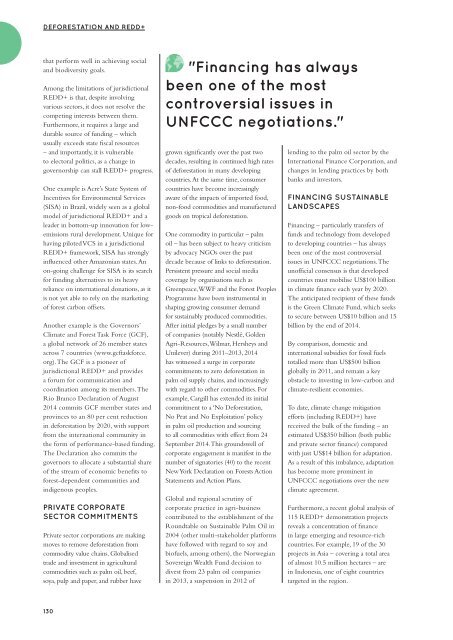Climate Action 2014-2015
You also want an ePaper? Increase the reach of your titles
YUMPU automatically turns print PDFs into web optimized ePapers that Google loves.
DEFORESTATION AND REDD+<br />
that perform well in achieving social<br />
and biodiversity goals.<br />
Among the limitations of jurisdictional<br />
REDD+ is that, despite involving<br />
various sectors, it does not resolve the<br />
competing interests between them.<br />
Furthermore, it requires a large and<br />
durable source of funding – which<br />
usually exceeds state fiscal resources<br />
– and importantly, it is vulnerable<br />
to electoral politics, as a change in<br />
governorship can stall REDD+ progress.<br />
One example is Acre’s State System of<br />
Incentives for Environmental Services<br />
(SISA) in Brazil, widely seen as a global<br />
model of jurisdictional REDD+ and a<br />
leader in bottom-up innovation for lowemissions<br />
rural development. Unique for<br />
having piloted VCS in a jurisdictional<br />
REDD+ framework, SISA has strongly<br />
influenced other Amazonian states. An<br />
on-going challenge for SISA is its search<br />
for funding alternatives to its heavy<br />
reliance on international donations, as it<br />
is not yet able to rely on the marketing<br />
of forest carbon offsets.<br />
Another example is the Governors’<br />
<strong>Climate</strong> and Forest Task Force (GCF),<br />
a global network of 26 member states<br />
across 7 countries (www.gcftaskforce.<br />
org). The GCF is a pioneer of<br />
jurisdictional REDD+ and provides<br />
a forum for communication and<br />
coordination among its members. The<br />
Rio Branco Declaration of August<br />
<strong>2014</strong> commits GCF member states and<br />
provinces to an 80 per cent reduction<br />
in deforestation by 2020, with support<br />
from the international community in<br />
the form of performance-based funding.<br />
The Declaration also commits the<br />
governors to allocate a substantial share<br />
of the stream of economic benefits to<br />
forest-dependent communities and<br />
indigenous peoples.<br />
PRIVATE CORPORATE<br />
SECTOR COMMITMENTS<br />
Private sector corporations are making<br />
moves to remove deforestation from<br />
commodity value chains. Globalised<br />
trade and investment in agricultural<br />
commodities such as palm oil, beef,<br />
soya, pulp and paper, and rubber have<br />
"Financing has always<br />
been one of the most<br />
controversial issues in<br />
UNFCCC negotiations."<br />
grown significantly over the past two<br />
decades, resulting in continued high rates<br />
of deforestation in many developing<br />
countries. At the same time, consumer<br />
countries have become increasingly<br />
aware of the impacts of imported food,<br />
non-food commodities and manufactured<br />
goods on tropical deforestation.<br />
One commodity in particular – palm<br />
oil – has been subject to heavy criticism<br />
by advocacy NGOs over the past<br />
decade because of links to deforestation.<br />
Persistent pressure and social media<br />
coverage by organisations such as<br />
Greenpeace, WWF and the Forest Peoples<br />
Programme have been instrumental in<br />
shaping growing consumer demand<br />
for sustainably produced commodities.<br />
After initial pledges by a small number<br />
of companies (notably Nestlé, Golden<br />
Agri-Resources, Wilmar, Hersheys and<br />
Unilever) during 2011–2013, <strong>2014</strong><br />
has witnessed a surge in corporate<br />
commitments to zero deforestation in<br />
palm oil supply chains, and increasingly<br />
with regard to other commodities. For<br />
example, Cargill has extended its initial<br />
commitment to a ‘No Deforestation,<br />
No Peat and No Exploitation’ policy<br />
in palm oil production and sourcing<br />
to all commodities with effect from 24<br />
September <strong>2014</strong>. This groundswell of<br />
corporate engagement is manifest in the<br />
number of signatories (40) to the recent<br />
New York Declaration on Forests <strong>Action</strong><br />
Statements and <strong>Action</strong> Plans.<br />
Global and regional scrutiny of<br />
corporate practice in agri-business<br />
contributed to the establishment of the<br />
Roundtable on Sustainable Palm Oil in<br />
2004 (other multi-stakeholder platforms<br />
have followed with regard to soy and<br />
biofuels, among others), the Norwegian<br />
Sovereign Wealth Fund decision to<br />
divest from 23 palm oil companies<br />
in 2013, a suspension in 2012 of<br />
lending to the palm oil sector by the<br />
International Finance Corporation, and<br />
changes in lending practices by both<br />
banks and investors.<br />
FINANCING SUSTAINABLE<br />
LANDSCAPES<br />
Financing – particularly transfers of<br />
funds and technology from developed<br />
to developing countries – has always<br />
been one of the most controversial<br />
issues in UNFCCC negotiations. The<br />
unofficial consensus is that developed<br />
countries must mobilise US$100 billion<br />
in climate finance each year by 2020.<br />
The anticipated recipient of these funds<br />
is the Green <strong>Climate</strong> Fund, which seeks<br />
to secure between US$10 billion and 15<br />
billion by the end of <strong>2014</strong>.<br />
By comparison, domestic and<br />
international subsidies for fossil fuels<br />
totalled more than US$500 billion<br />
globally in 2011, and remain a key<br />
obstacle to investing in low-carbon and<br />
climate-resilient economies.<br />
To date, climate change mitigation<br />
efforts (including REDD+) have<br />
received the bulk of the funding – an<br />
estimated US$350 billion (both public<br />
and private sector finance) compared<br />
with just US$14 billion for adaptation.<br />
As a result of this imbalance, adaptation<br />
has become more prominent in<br />
UNFCCC negotiations over the new<br />
climate agreement.<br />
Furthermore, a recent global analysis of<br />
115 REDD+ demonstration projects<br />
reveals a concentration of finance<br />
in large emerging and resource-rich<br />
countries. For example, 19 of the 30<br />
projects in Asia – covering a total area<br />
of almost 10.5 million hectares – are<br />
in Indonesia, one of eight countries<br />
targeted in the region.<br />
130












